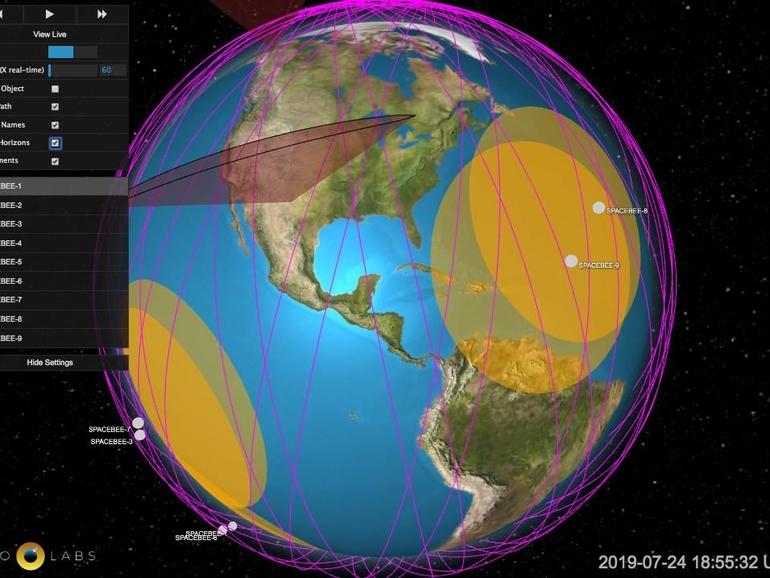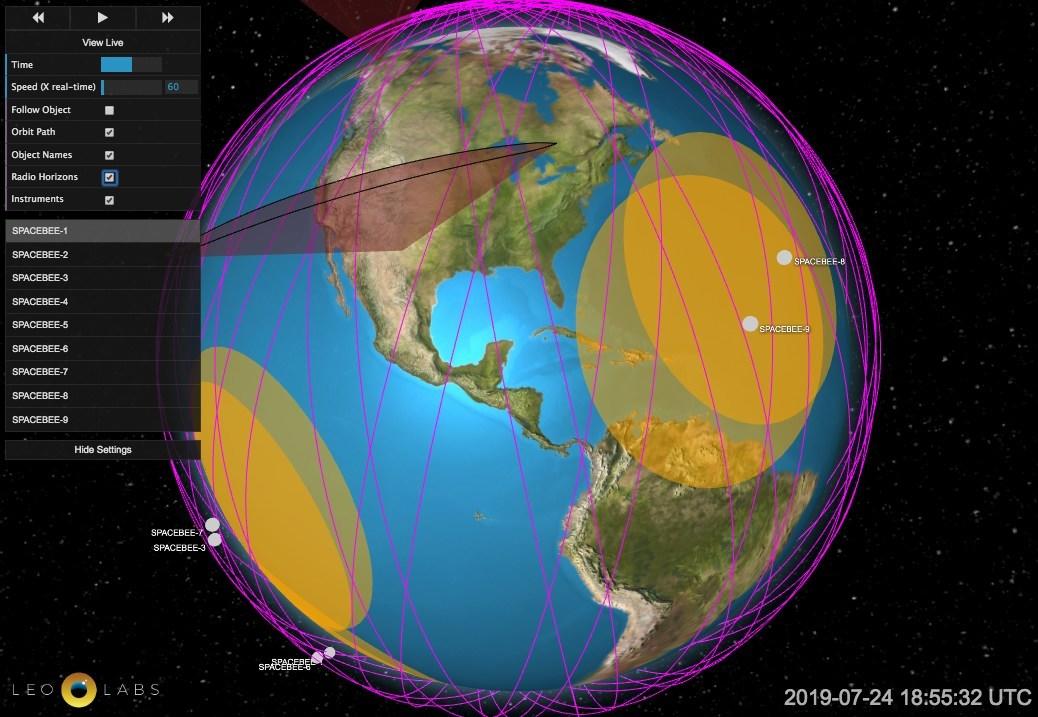
Frame from LeoTrack, a commercial low-earth orbit (LEO) satellite tracking service operated by Menlo Park, California-based LeoLabs
If there is to be a “6G Wireless,” its proponents will need to learn some significant lessons from the era of 5G. Already, 5G Wireless as a market strategy is four years old. The R&D divisions of telecommunications firms whose 5G rollouts are well under way, are now looking ahead to whatever the next version of wireless may be. . . or, at least, they’re trying to. So far, what they’re seeing may be a bit far out.
“6G must deliver an outcome that is aligned with real needs,” remarked David Lister, Head of 6G Research and Development Technology at Europe’s Vodafone Group, “and deliver outcomes that are sustainable and commercially driven.” Lister was speaking at an annual conference called the 6G Symposium. Yes, there is already an annual 6G Symposium.
Why 6G is not a standard yet
And yet there isn’t quite a 6G. Back in 1998, the leading stakeholders in global telecommunications formed the 3GPP consortium, to officially designate which technologies belong to a “G” and which don’t. 3GPP has yet to formally adopt any timeline for the development of anything called “6G Wireless.” Neither 3GPP nor any other industry group has endorsed or ratified any standard, set of standards, or placeholder for standards to come, with a “6” in it. (Officially, 3GPP has scheduled dates for Release 18 of global standards, though the forthcoming Release 19 is presently slated for 5G.) Theoretically, future releases beyond those the organization has already planned, could be designated “5G.” Possibly, though not as likely, 3GPP could stop designating its releases with any “G” at all — there’s no rule that there must be a “6G” or a “7G.”
Nevertheless, major telecommunications equipment and service providers have hired or appointed 6G strategy leads and research chiefs, attaching “6G” to their job titles. Vodafone’s David Lister is just one example.
These new 6G department heads may not all share a mutual purpose just yet. Certainly not all are presently 5G stakeholders. However, they do appear to share one common job function: articulating some facsimile of a desirable future — one where 5G may be comfortably discussed in the past tense.

Vodafone’s David Lister
“The traditional focus in generational networks has always been on the radio and the core,” continued Lister. “5G broke that history. It started a transition towards more IT architecture, cloud-native, software-based networks. And I think, as we are increasingly in this IT domain going forward, we can expect future technologies to be introduced in an agile way, not necessarily encumbered by ten-years-generational thinking, but more incrementally, with regular feature improvements.”
Are we already done with 5G?
5G is not yet the success its stakeholders promised. Of all the bountiful transformations to business and culture to be brought forth by 5G, which we’re still being told are forthcoming, connection speed tops that list. And so long as 5G must co-exist with 4G LTE during the transition period, that promised speed just isn’t there today.
Ranking a close second behind speed on that list of promises is functionality. A May 2021 report from Ericsson Consumer Lab [PDF] surveying more than 30,700 participants revealed that 7 of 10 respondents were dissatisfied with the lack of new and innovative apps and functionality made available by 5G. Among South Korean network users in particular, their general dissatisfaction with the launch of 4G in April 2012 (26 percent satisfaction) remains essentially unchanged following the launch of 5G seven years later (27 percent).
A new “G” is supposed to be exciting. We’ve been promised transformational applications whose benefits we can not only immediately see, but feel. That excitement is supposed to directly translate into revenue. The more excited customers are about the network, the greater the revenue stream.
But this has not actually happened. As Ericsson’s survey data indicates, not since Apple’s introduction of the iPhone — the culmination of 3G — has such a wellspring of excitement and enthusiasm ever materialized for the network. Should 6G become a thing, telcos cannot afford to simply repeat the 5G experience, and expect a different outcome.
What to expect from 6G that would be any different

Stephen Douglas
“One thing is clear: 6G is going to be an amalgam of complementary technologies, coming to deliver new sets of use cases and values,” remarked Stephen Douglas, head of 5G/6G strategy for UK-based network engineering firm Spirent Communications. On Douglas’ list: highly directional, “pencil-beam” antennas that receive terahertz-level frequencies for vastly greater data rates; transmitters whose capability of sensing the environments in their respective vicinities could enable sub-centimeter global radar; and wireless sensors implanted on users’ bodies, for what he calls body-area networks (BAN).
Assuming any of this is even physically possible, this system — or something resembling it — would need to supplement 5G rather than replace it. For such a vision of 6G to become feasible, 4G will need to have been completely excised from telecom networks. The goals which would lead telcos to begin phasing out 5G, probably sooner than they’d planned, today tend to center around the following themes:
- Line-of-sight, free-space connections. Connecting every 5G base station to every other one in its vicinity, in a perfect mesh, using terrestrial fiber optic cable, is not possible. 5G has sought to address this obstacle by leveraging millimeter-wave communications (mmWave) to bridge backhaul gaps over difficult terrains. So far, however, successful trials of mmWave have been slow in coming. But a movement is under way to resolve these logistical issues, enabling lasers to beam line-of-sight (LoS) signals across terrestrial hops of just a few miles each, for connections where laying physical cable, and then maintaining it, wouldn’t be practical. And where LoS isn’t practical, engineers are working on synthetic mirrors that may act as passive reflectors, called reconfigurable intelligent surfaces (RIS) — metals that can change their own reflectivity characteristics when the weather changes.
- A reformed service model. It was 4G that gave rise to the idea that some of the network’s control and management functions could be shifted to a cloud platform — even a public cloud, if the security was there. 5G Multi-access Edge Computing (MEC) has popularized the idea that industry leaders can actually own and operate their own wireless networks, leading many (admittedly, those outside telcos) to speculate as to whether wireless network operation as a service could be a viable product, replacing and superseding Wi-Fi for major industries.
- Terahertz spectrum. Up until very recently, the popular belief has been that, because terahertz (THz) radio frequencies would be useless for broadcasters, they’d be useless altogether. But in recent years, and even weeks, researchers have discovered that highly directed beams no wider than a pencil can be steered along paths using passive reflectors (RF mirrors), ping-ponging from point to point for at least several hundred yards, and perhaps eventually miles. 6G advocates point to this discovery as a possible catalyst for launching research into “4D-video,” whose projections some say you should be able to smell and touch, as well as see and hear. Applications involving this much data, these advocates claim, would only be feasible through wireless links at frequencies hundreds or thousands of times beyond the gigahertz (GHz) spectrum currently being allocated to 5G.
- Artificially intelligent network adaptivity. Enterprise IT is already familiar with the concept of software-defined networking (SDN), in which virtual nodes are mapped to physical nodes so that functions and applications perceive only the networks they need to use. Academic researchers suggest that the performance levels required for high-priority applications such as real-time telemedicine, perhaps coupled with haptic communications (enabling, for example, remote surgery), can never be achieved with 5G as its practitioners envision it. A kind of virtual overlay may need to be “imprinted” onto the 5G network by way of SDN, and since we’re talking about the entire global network, the only way to achieve this practically may be through AI-endowed network proxies — a technology that would require 3GPP-directed integration.
- A redefinition of “communication” itself. In discussions around this objective, the word “teleportation” may actually be heard more frequently than you’d expect. Here, engineers are advocating in favor of communication systems that convey the full illusions of presence, so that people (however aided by electronic devices or headgear) may feel, touch, and even smell the subjects of their conversation. The bandwidths required for this level of “tele-presence,” they say, far exceeds what 5G could possibly provide for.
The easiest route to a marketing theme for 6G, you’d think, would be to talk about more speed. That theme might work, if there were some history of speed improvement to back it up. Without an appreciable speed boost for 5G, extending the speed promise to 6G could look too much like kicking the proverbial can down the road, for the next generation to tackle. If there’s anything that stands in the way of truth, there’s its own stubborn veracity.
So before they can begin building new technologies in earnest, the first 6G advocates are beta-testing narratives on their prospective customers, if you will, to see what fits and what doesn’t.
Theme 1: Castles in the sky
In March 2019, the FCC adopted an order opening up a total of 21.2 GHz of radio spectrum, for unlicensed, experimental use, at frequencies ranging between 95 GHz and 3 THz. Until at least 2029, the Commission ordered, “innovators and entrepreneurs” would be given free and full access to these valuable patches of radio frequency, although famously, wireless and satellite providers disagreed as to whom the Commission was referring.
As the world emerges from the pandemic to find its roads and bridges having crumbled some more, its lead water pipes more decayed, the roofs of its schools caving in, and neighborhood foundations resting on sewers whose pipes have already washed away, there’s more than a bit of skepticism over whether a new network of low-Earth-orbit (LEO) satellites should be considered a national infrastructure priority.
The counter-argument being posed by the new 6G advocates is this: The wireless infrastructure we have, even with 5G, is woefully inadequate to support the applications we want.
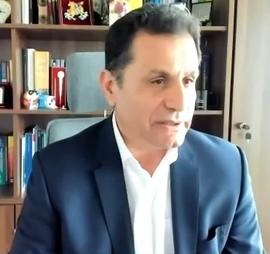
Prof. Rahim Tafazolli
“We need to realize the fact that we cannot provide ubiquitous coverage everywhere only by terrestrial means,” remarked Prof. Rahim Tafazolli, who heads the University of Surrey’s Institute for Communication Systems, speaking at 6G Symposium. “We need to look seriously at low-Earth-orbit in a complementary fashion, not in a competitive fashion. The main challenge here is, can we provide direct access between satellite and user equipment — mobile phones?”
Over the past decade, one of the most visible proponents of a global mesh scheme has been Samsung. Last year, Samsung began injecting new life in an otherwise old idea by attaching it to 6G.
Way back in 2015, Samsung announced its interest [PDF] in building a constellation of some 4,600 LEO satellites, orbiting low enough to minimize signal latency, though not high enough to achieve geostationary orbit. Knowing full well that 5G was still in the embryonic phase of development, then-head of Samsung Research, Farooq Khan (now CEO of 5G security firm Exium) argued in favor of satellite-oriented mmWave as an alternative to fiber optic cable for high-capacity data backhaul — effectively “grounding” 5G in space. It’s a well-known fact, Khan asserted to folks who never knew this fact, that the propagation of signals in free space is about 1.4 times faster than through fiber cable.
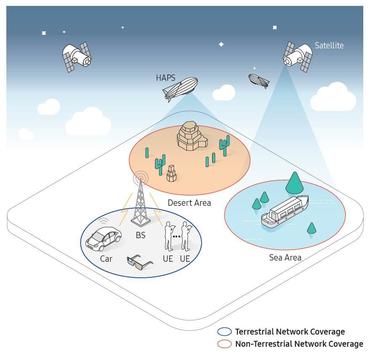
Samsung

Recently, Samsung began tying this LEO concept to a 6G-related initiative, calling LEO a “megatrend toward 6G.” In this diagram from its recent white paper, the company foresees high-altitude platform stations (HAPS), like signal-reflecting dirigibles, partnering with LEO to provide signal coverage in areas not supported by terrestrial base stations (BS). It’s a toned-down message from the 2015 edition, perhaps more aware of the fact that base station operators are telcos that are not willing just yet to give up control of their end-to-end coverage. Since LEO satellites move relative to the Earth, any network node that covers users at sea for any given hour, may cover users on land the next hour.
If the world had a single 6G vendor — perhaps a state- or multi-nationally sponsored monopoly — this type of global configuration might not be a problem. As things stand, however, LEO satellites are not stationed high enough above the atmosphere to become geostationary. So the only way for an LEO operator (whether or not it’s affiliated with a telco) to operate an LEO network, would be for it to be given the freedom to claim the entire globe as its real estate. The only way to do that safely may be to lay claim to a narrow band of altitude, in a similar way to how a radio operator is granted claim to a frequency. In the absence of a global altitude-regulating agency, and with geodiplomacy between nations in the state it is today, any such claim, regardless of who makes it, won’t be granted much merit.
So when would the skies become too cluttered for Samsung’s dream to be viable? An October 2020 NASA letter to the FCC suggests this has already happened. Objecting to the stated plans by a firm called AST & Science to build what it calls “the first and only space-based cellular broadband network to be accessible by standard smartphones,” NASA’s Commercial Space Transportation Interagency Group warned the private group’s satellites would be situated too close to a group of satellite constellations that NASA operates with partners, called the “A-Train.” The letter went on to claim AST’s constellation “contains extremely large satellites in a debris-rich orbital regime and will therefore experience a very large number of satellite conjunctions, certainly with debris objects and potentially with A-Train satellites themselves.”
In saying so, NASA inadvertently revealed that space is already too cluttered even for its own operations. Space, in other words — at least, the space we really want for 6G — may be taken.
Theme 2: A new business model for service providers
“We often talk about going beyond connectivity,” remarked Aaron Boasman-Patel, vice president of AI and customer experience at telco industry consortium TM Forum, during a recent webcast produced by UK-based 6GWorld. “What 5G and, then towards the end of the decade, 6G will teach us is, how important connectivity is as an underlying technology.”
Boasman-Patel perceives 5G as a foundation for the formation of a kind of software and services market, which would itself be 6G. This upper-level market would function more like cloud services and IT, where vendors cohabit a space but tend not to own it end-to-end.
“The hardest thing to understand, I say, is not necessarily the technology,” he continued. “The technology is only one piece of the puzzle. You have to fundamentally change your operating and your business models, and say, how can the technology enable us to do that, as opposed to the other way around?”
One configuration being discussed would enable much smaller organizations than telcos to become telco service providers in limited areas, and enterprise customers themselves to own patches of wireless coverage areas. Such a configuration would be an extension of the Multi-Access Edge Computing model currently under way for 5G, where companies with their own corporate campuses operate their own towers — giving them a way to replace limited-range Wi-Fi with longer-range, higher-bandwidth service.
But if subdividing the network is the solution to putting high bandwidth in place, what would the incentive be for telcos to permit the wholesale subdivision, and subsequent conquering, of major portions of their own networks, using their own technologies?
“I don’t think it’s as simple as it sounds,” remarked TM Forum’s Boasman-Patel, in response to this question from ZDNet. He continues:

Aaron Boasman-Patel
Fundamentally, what we’re saying is, CSPs [communications service providers] will probably own the connectivity. That is why they’re building out all of those services, and really focusing on having the best connectivity possible. If you speak to Verizon, that’s their number-one mantra; if you speak to Orange, their mantra; speak to Vodafone, that’s what they’re going to do. That is critical, because as I think we’ve seen now with COVID and different stages of people working from home, connectivity is the core of everything else. I think connectivity’s getting exciting, because people need the speeds. They want the guarantee of service.
They will always own that connectivity. But where it becomes interesting is the applications that sit on top of it. I don’t believe that CSPs will own the edge in every single location, and be able to offer all those services. But what if we migrate to [an open model] where you can buy and provision a service, and you can share that edge capability? So in some areas where you’ve got stronger infrastructure, you can move those applications. . . between CSPs, to give you better coverage. That way, you’re getting revenue from your application, not having to build out infrastructure where it doesn’t make sense.
(Note: We at ZDNet have historically used “CSP” as an abbreviation for “cloud service provider,” but among European telcos, the “C” stands for “communications.”)
So in Boasman-Patel’s view, 6G could bring about a new business model where individual telcos drive “end-to-end” communications, as well as continue to maintain single customer accounts. In exchange, they’d need to be content with shortening the distances between one end and the other, and ceding control of the customer edges to a more IT-oriented marketplace, where the “C” stands for “cloud.”
Theme 3: Supplementing or replacing microwave frequencies with terahertz
“What 6G is not is a new business model,” stated Prof. Tafazolli. “It is not 5G plus AI, it is not OpenRAN, it is not higher speed, and it is not more secure. 6G should bring new capabilities that 5G cannot deliver, and I believe [one example] is time synchronization.”
The technology to which Prof. Tafazolli refers here, means more than just calibrating metronomes. He’s one of a growing group of engineers who foresee the possibility of a future network where radio waves — whose frequencies range between just below 6 GHz (the “sub-6” band) to at or near terahertz level (THz) — can be steered through metropolitan areas, from point to point, like ping-pong balls bouncing off metal pans in an obstacle course. The metal, in this case, would include an as-yet-theoretical concept for adapting the reflectivity of metal sheets in real-time, called reconfigurable intelligent surfaces (RIS). We could be talking about metal plates on the outsides of buildings or, in instances where beams are being steered indoors, literally reflective wallpaper.
Imagine if the metal pans in this obstacle course could shift their angles ever-so-slightly to compensate for changing weather. RIS relays would need to do precisely this. But a functional RIS network would require millions upon millions of such surfaces, attached to buildings, windows, and skyscrapers. They could make the world look as though graffiti had been left everywhere by an alien species who communicated in QR codes. The collective movements of surfaces in any such network would require a level of orchestration never achieved before in human history. Thus, time synchronization. Technologies on the subatomic level of quantum processors may be called for here.
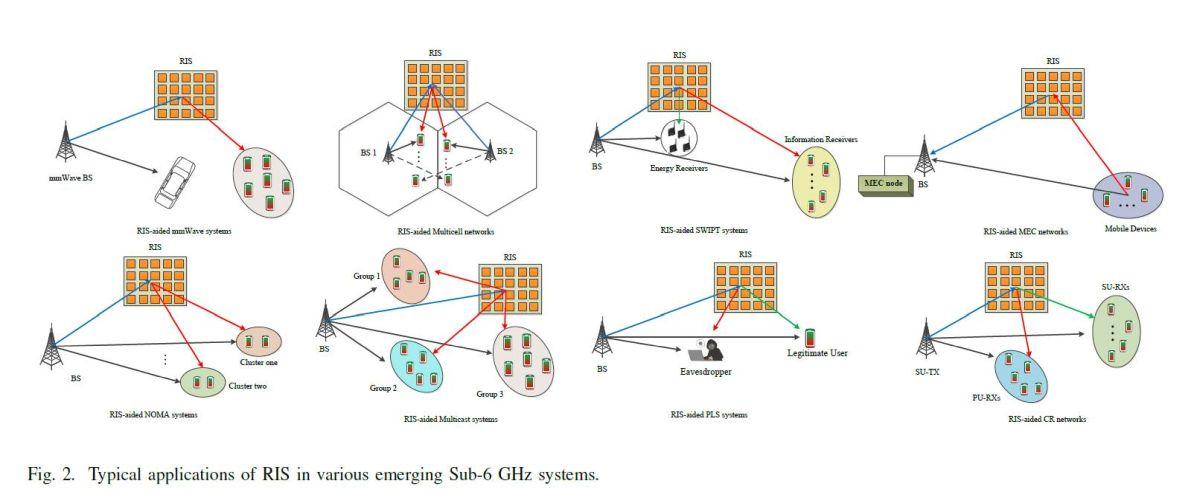

A May 2021 paper [PDF] suggests that a completely passive RIS surface may be more effective (and obviously more energy efficient) at steering signals around physical obstacles, than the multi-antenna MIMO system implemented by 5G. Today’s MIMO can overcome the path loss suffered by 5G mmWave and even sub-6 signals, by packing very large antennas receiving multiple frequencies in very small spaces. But that process consumes tremendous power, which 5G was supposed to be saving. RIS would get around this problem through the use of metamaterials, capable of changing their own reflectivity in response to voltage changes in an underlying diode, triggering phase shifts. Those shifts are literally reflected in any signal that bounces off of them, enabling them to be tuned in real-time, according to changing environmental conditions.
The IEEE researchers tout one foreseeable additional benefit to RIS: the ability to make high-frequency signals secure without the aid of digital or quantum cryptography, through the addition of artificial noise and phase transitions that a surreptitious listener, by virtue of being in a different location from the intended receiver (as fantastic as this sounds), would be unable to filter out.
Theme 4: Overlaid network intelligence
Enabling this highly sensitive and dynamic system of signal exchange would inevitably require AI functionality beyond anything ever implemented in a communications network. Researchers with St. Joseph Engineering College in Mangalore, India, are proposing that the required AI for 6G may be so extensive that AI should actually become the foundation of the entire network’s operations. In other words, 6G functions should reside on an AI platform, rather than the other way around.
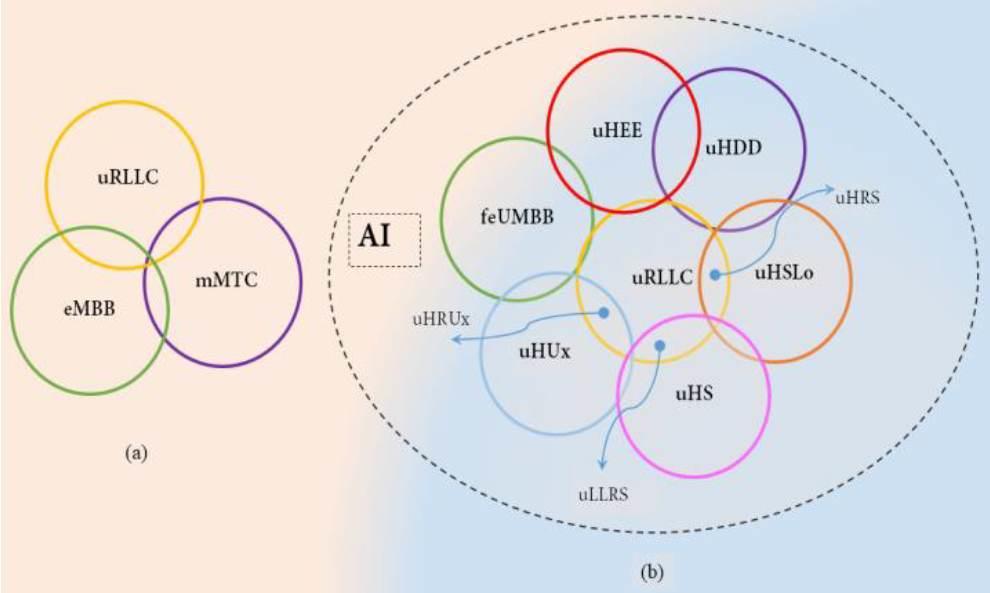
From a 2020 IEEE paper.

In this diagram from an IEEE paper by Profs. Jagadeesha Brat and Salman AlQahtani, 5G on the left is represented by some of the components in 5G New Radio (5G NR): Enhanced Mobile Broadband (eMBB), Massive Machine-Type Communications (mMTC), and Ultra-Reliable Low-Latency Communications (uRLLC). Picking up on 3GPP lower-casing its adjectives, Brat and AlQahtani pile on several new components of a theoretical 6G radio core on the right, adding ideas like “ultra-High Security” (uHS) and “ultra-High Sensing and Localization” (uHSLo), which in this case are suggestions rather than formal projects.
The theme they convey may be prescient: Whatever 6G becomes, it’s more likely than not to subdivide into even more technology tracks. When that happens, they’ll all need something to bring them all together, and at least make them seem smart.
On top of all this, remarked 6GWorld Managing Editor Alex Lawrence in a note to ZDNet, the intelligence built into any new wireless network will need to extend to all the devices linked into the network. That includes not only wireless phones, but wireless vehicles. Wrote Lawrence:
Building security by design into a new network will be a first, and again will demand new approaches and probably business models. And then there are other things to think about as the physical world interacts with the digital one, such as ‘functional safety’ and resilience. That’s based on the assumption that no security is going to be 100% perfect forever, especially if you’ve got nationally vital elements being run through the network. Enemies of the state might love to hack, for example, all the autonomous vehicles in a country. Functional safety means designing the cars so that, even if they’re hacked, or even if they lose their connection, the car won’t just drive into a crowd or anything. And resilience means making sure that, if an attack shuts down one car, it won’t spread easily to other cars and it’s easy to get the attacked car up and running again.
Theme 5: A whole new meaning to “headend”
At this signpost, the wise man said, you cross over into the Twilight Zone.
“What type of mobile devices will disrupt the wireless industry and drive beyond 5G wireless systems in the same manner that the iPhone and the IoT did?” reads an April 2020 white paper produced by IEEE senior and student members [PDF]. Submitted for your approval: Your brain, enhanced through the implanting of a bio-mechanical interface (BMI), within which are probes that make direct contact with the surface.
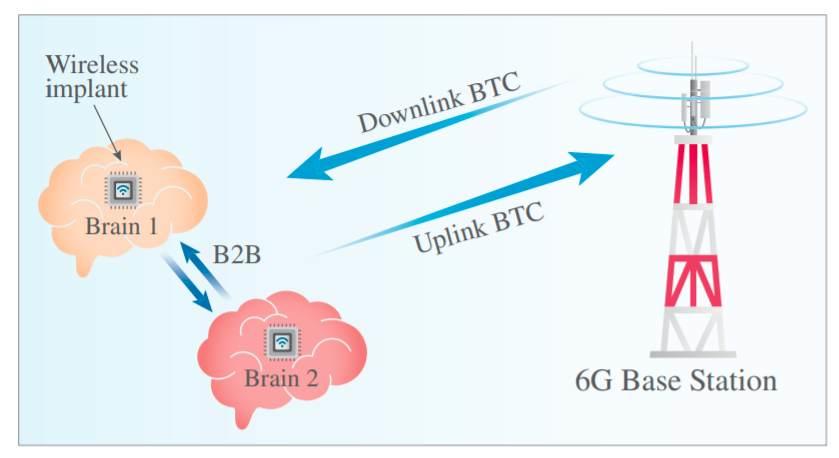

IEEE Senior Members Pedro Nardelli and Renan Moioli propose the creation of a truly neural network they call BTC. Without the real-world experiments to prove this just yet, they suggest the following: Once it becomes possible for base stations to achieve extremely high-frequency connectivity, the next natural progression may be to take biological devices that already generate natural signals at those frequencies, and interface them with the wireless network. The BTC team wrote:
…The shift toward implants is further motivated by several emerging wireless services, such as immersive Extended Reality (XR) and BMI, in which the human body and brain become an integral part of the wireless service. In these services, it will soon become necessary to provide communication links among, not only machines (MTC) and human users (HTC), but also among the brains of different users. Hence, we foresee that BTC will be the next frontier in wireless connectivity… BTC links must be designed in a way to seamlessly connect a human brain to a wireless network and potentially provide two-way communication among the user’s brain implants and the various network and IoT devices. A unique feature of BTC links is that they will require the network to match the capabilities of the human brain — arguably the most powerful computer in the world.
The apparent upshot here: Really cool games, for one. Next, of course, comes telepathy, linking brains not only with 6G routers and remote cameras, but other brains. One principal requirement, of course, would be “the most powerful computer in the world,” which immediately recalls scenes from a Douglas Adams novel.
All this comes on the heels of efforts by 5G stakeholders, along with scientists, academics, and more than a few journalists, to debunk the myth that 5G sought to implant chips in your brain. Since there is no official 6G wireless standard, we can say for now the same holds true for 6G. There has always been an element of science fiction in any speculation about a future technology — for instance, the implication in any study of quantum entanglement that molecular transport may indeed be possible. Sometimes sci-fi is a useful tool, helping us rediscover where the borderlines of sensibility actually lie.
What if there isn’t a 6G?
Which leads us to this very relevant question. The stakeholders in wireless networks have a vested interest in maintaining control over the gateways through which their networks are accessed. We talk a lot about communications technology evolving to become more like information technology, where there are many more players in competitive fields, and no single vendor owns the customer. And we observe a variety of technologies on the horizon (most of them real) that provide evidence to that end.
But each of these technologies would operate in different spaces, with space itself (outer space) being just one level. The edge, where processing and high-capacity storage takes place closer to the end customer, would be another space. And if fiber optic backhaul must co-exist with both microwave and terahertz line-of-sight relays, ownership of the data distribution network may be partitioned between at least three layers, each with its own supply chain and management scheme.
All of this would render it much more difficult for telcos (the Verizons, Vodafones, and Oranges of the world) to claim “ownership” of the wireless customer. So why bother building an economy of scale if the builders themselves are out-scaled? Put another way, why bother with 6G at all?

Oliver Korfmacher
“I think the subscriber data itself, at least in 5G, at least for a given set of subscribers — say, residential — will remain in one database,” replied Oliver Korfmacher, Vice President for Technology and Telecoms for Stockholm-based telco cloud platform provider Enea, speaking to a 6GWorld panel. “We’re currently harvesting the benefits from having a single, centralized data management, and we will not turn this away immediately.
“In 6G, this might change,” Korfmacher pivoted. “Very likely, we will see the partitioning of subscriber data between different vendors — [it] will be the next big thing.” Since 5G is built to support user equipment (UE) mobility and roaming (enabling one tower to pick up a signal when a phone moves out of range of a nearby tower), it makes sense to keep UE subscriber data centralized. For any system being envisioned as 6G, he believes, such centralization — which some might call “lock-in” — may not be as necessary.
Since holding onto one’s customers remains key to the success of 5G Wireless strategy, 6G might very well co-exist with 5G after all. . . as its competitor.
Stated Aaron Boasman-Patel:
If we’re going to get to this multi-vendor landscape, we really have to start to understand, how do you componentize the network? Now, that’s never been done before. We spend a lot of time talking about the IT layer, about the interfaces on the radio access network. To make all of this work, we’ve got to ride the way down into the network, which hasn’t traditionally been opened up. There’s lots and lots of vendor lock-in on the network side, and lots of resistence to actually de-componentize that into the different network functions.
We put the question to Prof. Henning Schulzrinne of Columbia University — the former CTO of the FCC.

Henning Schulzrinne
“I do see that, for at least the foreseeable future, we already have several, and a probably increasing number of, communications standards tracks,” Prof. Schulzrinne told us. “We’re going to have, currently, the carrier track — 5G from 3GPP, primarily, and related bodies. We’re going to have the enterprise version — largely still Wi-Fi, for the foreseeable future. That I don’t see going away. And increasingly, we’re having specialty networks like a WAN, and similar types of IoT-based, low-bandwidth, long-range, industrial-style networks that are more important, but niche networks, not general-purpose.”
Some, perhaps all, of the goals engineers and academics foresee for their respective, bright futures, may happen anyway without either 5G or 6G. And that may be a good thing, if we resume the original concept of a “G” as 3GPP perceived it: the technological specification for the core and accessibility of the wireless network. There may not have to be a split or a chasm among stakeholders, believes Prof. Schulzrinne, if everybody would concentrate on their own respective projects. The professor continued:
What I do see as an opportunity — and this is not guaranteed to succeed, is that we currently have a world where the Wi-Fi world and the carrier world are starting to converge, but still, they’re fairly different, so that a company has to make a choice. They’ll may go all-in on carrier-style technology like 5G for the enterprise. But you get the story. It’s still not a majority. It’s still hard to deploy. It requires a level of expertise in communication. You’re pretty much tied to a single vendor at that point — say, Nokia or Ericsson. It’s not well-integrated with enterprise management systems, because they’re designed as carrier-style systems. It’s not integrated with any existing Wi-Fi infrastructure, for a variety of practical and cost reasons. So I do see there is an opportunity — and this may be more of a 6G type of thing — to think more systematically about an architecture that can be scaled down, and more readily occupies the middle ground between a very basic, Wi-Fi access point architecture that we currently have in very small enterprises, and the carrier-grade, carrier-scale, 5G-ish style of architecture that we have.
Schulzrinne perceives an opportunity for a radically simplified architecture to occupy this middle ground, between the Wi-Fi router and the 5G tower. Whoever seizes this opportunity, he believes, will need to either train, or be able to train, the managers of these mid-range communications networks. Here is where things get interesting: Do carriers have an interest in cultivating such expertise among their customers? Don’t they run the danger of sacrificing the very element of their service that justifies their premiums? Continues Schulzrinne:
There’s a recognition that the carrier industry has to merge towards the enterprise architecture, as opposed to the opposite way. I see that as much more productive, simply because there’s just a lot more enterprise out there, than there is carrier out there, both in terms of numbers of people and numbers of deployed sites. I do see an opportunity there. But it’s too late to do that for 5G.
[ZDNet acknowledges the superb work of 6GWorld, its managing editor, Alex Lawrence, and his colleagues who set up 6GSymposium and its associated panels.]

